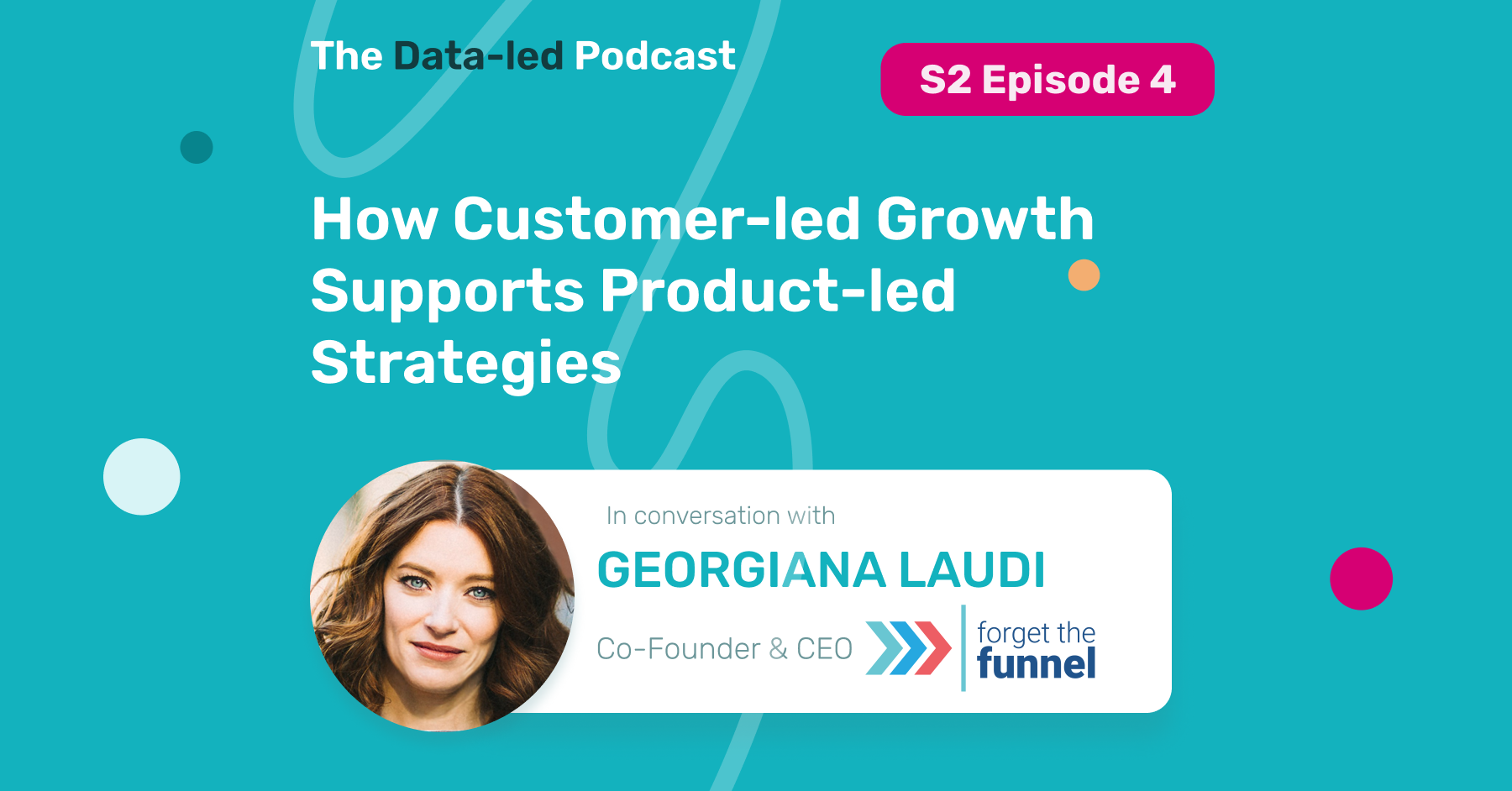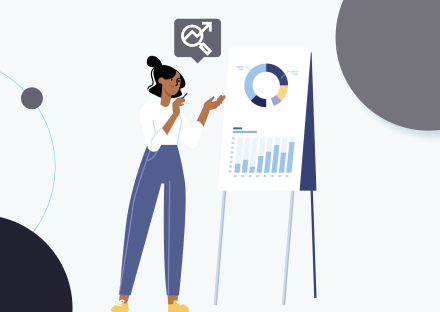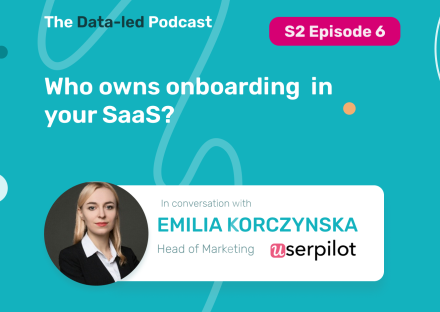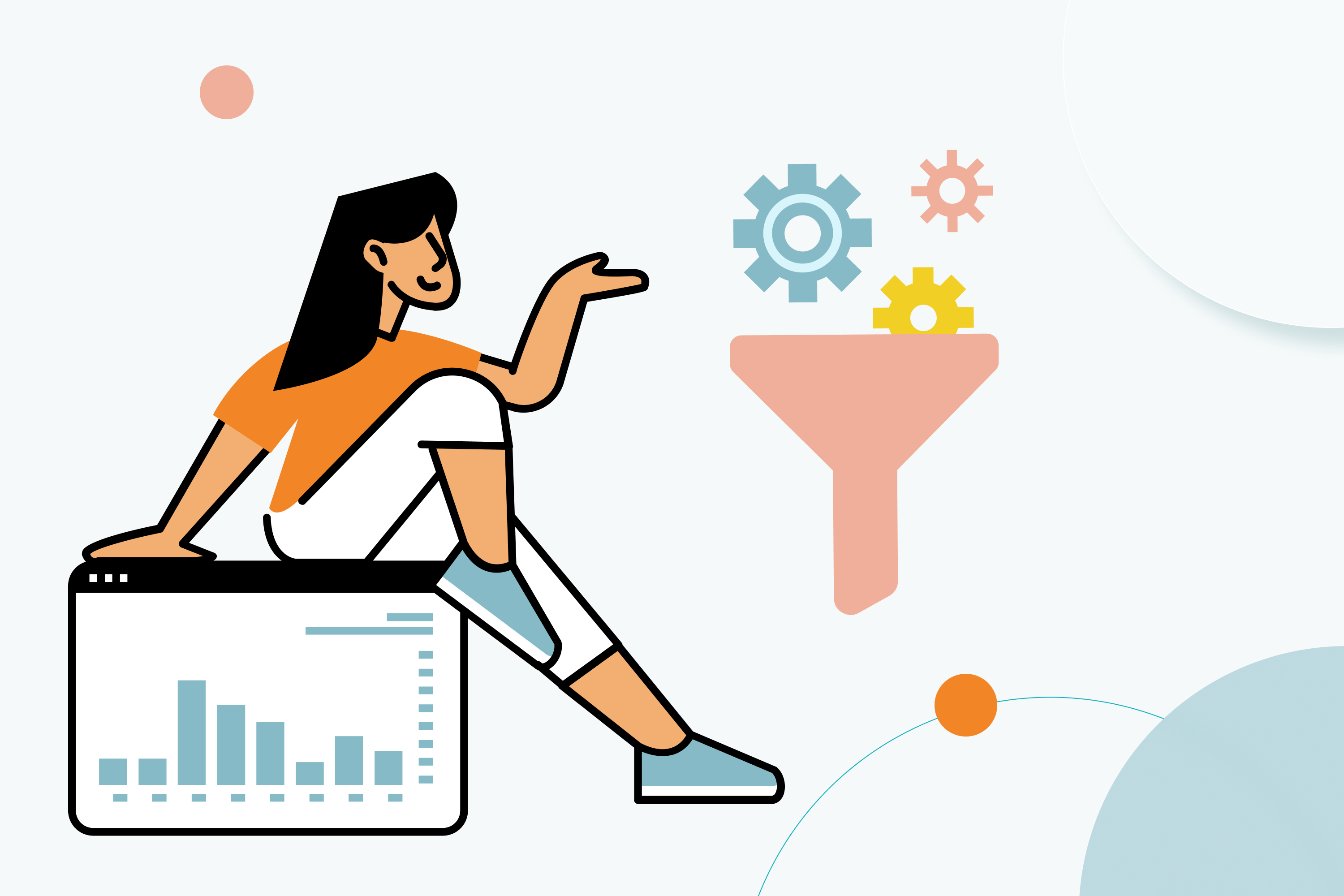In this podcast episode, join special guest Georgiana (aka Gia) Laudi, CEO and Co-Founder of Forget The Funnel, and Data-led Podcast host Claudiu Murariu, CEO and Co-Founder of InnerTrends, as they dive into customer-led growth and the critical role it plays in any business, particularly SaaS.
Here’s what they talked about:
- What a customer-led strategy is, and how it’s different from any other “-led” approach;
- How to build a customer experience journey, and why it’s important to get it right from the beginning;
- Why activation is one of the most critical stages in the customer journey, and how it’s defined;
- What KPIs are specific to a customer-led approach.
Subscribe on your favorite streaming platform for more episodes:
Listen on Apple Podcasts Listen on Spotify Listen on Google Podcasts Listen on StitcherWhat is a customer-led growth strategy, and how is it different from any other approach?
[G]: I believe that customer-led growth really lies as the foundational base to all of the other “-led” approaches.
Customer-led growth is a strategic approach that leverages customer insights to qualify and quantify customer value, and then operationalize and optimize the end-to-end customer experience.
It’s the base on which you would make decisions about how to be data-led, how to be product-led, or how to leverage strategies like a marketing-led approach or a sales-led approach. It will give you the answers as to how to leverage all of those other types of strategies.
We’re huge fans of product-led growth at Forget The Funnel; we love it as an approach, and we believe that you need, and are way better served in leveraging product-led strategies, when you understand really well your customers and have those insights to make decisions about how to serve them in an effective and also scalable way.
How do you build a customer journey, and why is it important to get it right from the beginning?
[G]: First things first; I long relied on the standard customer journey maps prior to taking this type of approach. I used the same resources everybody else did. I understood MQL, SQL, the customer lifecycle and pirate metrics.
Back in 2012, I was at a small event with Dave McClure describing pirate metrics, and I had this eureka moment, because I’d already been a marketer for about 10 or so years. I had this moment of, “Yes! Finally, there’s a framework to help communicate the value of marketing post-acquisition.” I was really, really excited at pirate metrics.
I don’t want to speak poorly of other approaches, however, they tend to be riddled with problems. They can be very generic, very formulaic, they assume that every customer and every product are the same, they put your customers into these boxes that make them from one company to the next, exactly the same.
That’s not an accurate depiction of your customer at all, let alone your product offering and how it helps them. So we don’t call it Customer Journey Mapping anymore; instead, we call it Customer Experience Mapping.
We like to start the customer experience with the customer out in the world, experiencing the problem that we help them solve. Even without us being part of the equation; they don’t necessarily know who we are, but they’re out in the world experiencing that problem that we solve, all the way through to absolutely loving our solution and telling their colleagues, or expanding in their usage of our product. All while they’re getting continued value from our product.
The buyer’s journey is just one little part of that. We find that customer experience mapping is more holistic, and gives us an opportunity to think not only about how we’re going to help customers make a decision about how to buy our product and become a paying customer, but also about what their life is prior to becoming a customer.
What does that feel like for them? How are they solving that problem today, so that when we do get in front of them for the first time, we’re speaking the right language, our message is resonating with what their current reality is. Customer lifecycles, buyer’s guides or whatever you want to call it, leave that critical component out.
Additionally, many of them leave out post-acquisition. So many customer journey maps end at acquisition. Acquisition is where the story begins, especially for SaaS companies, so to have a customer journey end at acquisition is very foolish for this type of business.
Customer journey maps – we think we understand them and everyone has one. But if you actually look at them, they’re oftentimes incomplete or very generic, or just not useful and actionable. So that’s why we tend to use the language of customer experience mapping instead. But at the end of the day, all that matters is that it works, it’s effective for your team, and it’s something that your team can run with.
[C]: I want to emphasize something you just said because it’s very important. The previous experience and knowledge the customers have as they turn to your product to solve their problem, regardless of if they already knew of your solution or not. Because I believe that the purpose of your solution is to be a puzzle piece that fits perfectly into their universe, which is why I love your framework so much.
Why is activation one of the most critical stages in the customer journey, and how do you define it?
[G]: Acquisition means different things to different people. Some people might define acquisition as somebody becoming a paying customer ; others may define acquisition as they acquired a lead, a trial, or a free sign up, etc. So even when I talk about activation, I tread lightly, because it means different things to different people.
For me, activation is that first value moment. But I know that for others, sometimes product activation, it’s thought of in the same way as product engagement. So I delineate between the two, and I tend to use terminology that actually looks at this customer experience through the customer’s lens versus through the product’s lens.
I still talk about product activation and product engagement, because people understand that. But I also try as much as possible to help the companies that we work with think about it in terms of delivering first value, or delivering value realization.
Just because, again, it’s through the customer’s eyes, which helps make that mental leap into thinking about not only what it means, but how we measure it, too.
So how I think about product activation is as a first value moment. It’s: what experience should you be providing to your new customers quickly after they’ve made that leap of faith to decide to try this thing on for size?
They’ve handed over their email address or whatever you’ve asked for in exchange to get them to try out your product. So what value can you deliver to them very quickly that’s aligned with the promises you made on the step before it?
You’re proving to them that they’re in the right place and that they are going to get what they came for. Making the decision about what that experience should be is really interesting. The opportunity is different from customer to customer, and product to product, which is why I believe so heavily in gathering those critical customer insights to get the answer to that.
That’s how I think of product activation: it’s that first value moment that reassures your new customers that they’re in the right place, and that their journey to learning your product is going to be worth it; and furthermore, is going to continue to propel them forward in their learning curve with your product.
I think about engagement as being closer to that value realization moment. It’s why they decided to sign up; what that customer job was (we talk a lot about the Jobs To Be Done theory), and we rely on that to help guide us as to what value realization should look like.
Tip: Use the JTBD framework to identify that promise, that value, to make sure you have the right promise in the first place.
I reverse engineer it from value realization to figure out how we’re going to help our customers solve their customer job, what that value realization looks like, and based on that, we work backwards to figure out the most appropriate product activation or first value experience for them.
There’s a big disconnect that happens. It’s very disappointing when we see that the promises that websites make tend to often be forgotten or shift once somebody gets into the product. The reason for that is a different team is responsible for the product versus the website.
This is a massive misunderstanding and disconnect in the world of product marketing right now. It’s chaos in terms of people’s understanding of what that role is. And so that disconnect between the website or whatever tool you’re using to acquire new customers and the product itself can feel like a huge divide sometimes.
What are the KPIs specific to the customer journey?
[G]: There are two KPIs that are universal in terms of their usefulness across the board:
- Whatever your primary call to action is on your website is a solid measure of interest in your product. You should continue to measure that because it helps you figure out how good of a job you’re doing at communicating your product’s value on your website.
- Similarly, measuring your ability to build awareness and increase awareness about your product could be measured by new unique website visitors or new users in Google Analytics.
How good of a job are you doing at attracting new people to your product? And how good of a job are you doing at communicating your value?
But these are only the very beginning of the story, because none of that matters if these customers are not a fit for your product.
Going back to the activation and engagement piece again or first value in the value realization piece – when we identify the customer job to be done, we do that research and gather those critical customer insights; when we ask questions like, “What was the moment you knew that our product was going to be the solution for you?”
Your best customers will provide insight into what value realization looked like for them. They’ll give you the answers to how successfully using your product plays out, and what product usage is meaningful.
Tip: Find the most engaged customers with your product, that have recently signed up so they remember how the world was before your product and interview them to find out why and how they chose you.
So I don’t pay any attention to weekly active, daily active, or monthly active if I can. If it’s relevant, sure – if your product is something that you have to log into weekly in order to get value out of it, then use WAU weekly active or weekly logins as some baseline measure of engagement with the product.
But that’s typically not the end of the story, because they could be logging in for any number of reasons. So meaningful product usage is how I would define the metrics for a healthy, happy, engaged customer.
And then I work backwards again on the activation side. We look for meaningful product usage to measure our ability to help customers get to a “value moment” or “success moment.”
Each of the stages of the customer experience we call success milestones, and we unpack each of those success milestones through the lenses of generally doing, thinking, and feeling.
Because if we pull those things apart, we get the “why,” we get the “what,” and we get an insight into what’s going through their minds, what are their potential objections, what’s motivating them to move forward, and what might be going on outside of the product – those success gaps that we have no impact over at all, like conversations they’re having with colleagues.
But also, what are the direct touch points we have with customers? So for each stage of the customer experience we deconstruct it in these ways. And that gives us insight into not only what they’re doing and what would be the most meaningful experience for them, but also, how we would measure our ability to get them there.
So we attach that qualitative element from the research and that quantitative product usage, and that’s how we identify our KPIs.
Final thoughts
- In customer-led strategies you put the customers first, their overarching experience before, during, and after discovering your product, to fully understand what is the value your product needs to deliver and how
- Customer experience journey is much more holistic than customer buying journey
- The customer-led approach will help you close the gap between marketing and product and will help you get to team alignment on what the overall customer experience should be, from acquisition to repeat product usage, and how you measure it
- Always remember who your audience is – it will not just make your business better, but it will make the world better as well.
Listen to the whole episode and subscribe to the Data-led Podcast on your favorite podcast platform:
Listen on Apple Podcasts Listen on Spotify Listen on Google Podcasts Listen on Stitcher




